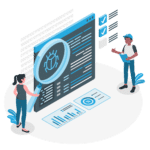Why Software Testing & QA Matters for Your Portfolio
For private equity (PE) and venture capital (VC) firms, the bottom line is the driving factor for investment decisions. Increasing EBITDA margins, driving operational efficiency, and ensuring a smooth exit are top of mind, as investors focus on strategies that compound value across their portfolios.
One area often overlooked as a key driver of these outcomes is software testing and quality assurance (QA).
The importance of QA as a business enabler is becoming critical. High-quality software isn’t just a technical asset; it’s a competitive advantage that accelerates growth and protects revenue.
This blog explores why software testing matters for your portfolio, how it contributes to today’s PE playbook, and actionable strategies your firm can adopt to reap its rewards.
Where QA & Testing Create More Value for Private Equity Firms
To understand why software testing is crucial, it helps to first identify the top priorities that guide PE firms when managing their portfolios.
- Improving EBITDA Margins: A company’s EBITDA (Earnings Before Interest, Taxes, Depreciation, and Amortization) reflects its financial health. Investors aim to cut costs and maximize efficiency to protect and grow these margins, especially when preparing for exits. Test automation is one avenue to enhance efficiency and drive more revenue, though it’s often overlooked.
- Scaling Operations: Portfolio companies are often primed for rapid growth. However, scaling becomes inefficient when technical barriers like software bugs or outdated infrastructures clog the pipeline.
- Reducing Risks During Exits: Buyers today require thorough technical due diligence during acquisitions. Unstable software and poor QA processes raise serious red flags that can derail deals or depress valuation multiples.
- Optimizing Profit: Whether through higher customer retention or reduced operational inefficiencies, every decision is assessed for its ROI potential. Enhanced QA keeps customers and speeds up releases to attract new ones.
With these key goals in mind, software testing emerges as a strategic lever, capable of transforming operational challenges into opportunities for value creation.
Learn more in this podcast: Impacting EBITDA: Testing is a Boardroom Decision.
How Should Firms Approach Software Testing and QA?
What is Software Testing, and Why Does It Matter?
Software testing is the process of evaluating and verifying that software works as intended while identifying any bugs, vulnerabilities, or inefficiencies. It’s an essential component of the Software Development Life Cycle (SDLC).
When done right, testing guarantees product stability, reliability, and usability, which are foundational to tech-enabled companies.
For PE firms, QA acts as the invisible force ensuring everything runs smoothly—from the apps customers use to the internal systems that streamline operations.
The Benefits of Robust Software QA
Here are three key ways QA impacts portfolio performance:
- Accelerate Development & Reduce Costs
By catching bugs and errors early, QA minimizes costly rework late in the development process. Automated testing tools further speed up releases, reducing manual labor costs.
- Increase Valuation Through Product Quality
High-quality software boosts customer satisfaction, reduces churn, and improves retention rates. A stable and reliable product becomes a stronger market asset, significantly lifting exit multiples.
- Minimize Risk in Tech Due Diligence
Proactive QA identifies hidden issues such as security vulnerabilities and tech debt before they escalate into major risks. This mitigates concerns during pre-acquisition assessments and enables smoother post-acquisition integration.
Why Software Testing & QA Matters for Your Portfolio
Operational Efficiency & Cost Reduction
Every PE firm seeks to optimize portfolio operations, and software testing plays a pivotal role. Poor software quality leads directly to inefficiencies such as high support costs, delayed releases, and decreased developer productivity.
Adopting test automation can drastically lower these costs while enabling engineering teams to focus on innovation. Automated testing not only saves time but also ensures consistent, repeatable results, creating a scalable approach to QA.
Key Insight: Costs increase exponentially the later a bug is found in the development process. A solid test automation framework can catch bugs earlier, significantly reducing correction costs and loss of consumer trust.

Scalability & Growth Enablement
Scaling a portfolio company requires robust infrastructure and reliable software. Unfortunately, technical debt or unstable coding often bottlenecks growth when businesses try to launch new features, integrate acquisitions, or expand into new markets.
Strong adherence to QA best practices help to resolve these barriers and prevent them in the future.
Robust QA ensures software scalability without sacrificing functionality, giving portfolio companies the agility to adapt and expand quickly.
Key Insight: It’s not just about getting the right technology in place; it requires an understanding of where to automate–where is the highest volume, the highest risk, and the greatest vulnerability? QA involves weighing those factors to build a solid foundation of testing and automation, so that your software scales logically.
Customer Retention & Revenue Protection
For PE-backed SaaS companies, churn is one of the most significant risks to revenue. Technical failures, software bugs, and downtime lead to poor user experiences that drive customers away.
Additionally, reputation damage can discourage new customers from adopting your platform, a likely result from security breaches or outrages that cause customers pain.
QA programs are your first line of defense against these issues. Rigorous testing ensures applications function exactly as users expect, safeguarding subscriptions and preventing revenue leakage.
Key Insight: Research shows that a 5% decrease in customer churn can increase profitability by as much as 25%.
Tech Due Diligence & Risk Mitigation
Effective QA doesn’t just optimize software; it mitigates risk.
During due diligence, the buy-side often scrutinizes the technical foundation of a target company. Outdated infrastructure, poor automation, and a lack of testing signal larger systemic issues.
Security risks compound with testing gaps, which can leave sensitive data open to breaches and other costly problems.
This can pose problems for investors looking to exit a portfolio company.
Post-acquisition, upgrading QA processes ensures stable integrations, reduces disruptions, and positions portfolio companies for long-term success and higher return on exit.
Key Insight: Robust QA processes encompass not just the technology to enhance security, but an approach that measures risk in relative terms. Risk should be assessed against value, so that manual safeguards are put into place for high-risk, high-value systems. Similarly, low-risk, high-value systems may require fewer guardrails and faster releases to better capitalize on gains.
How to Ramp Up Software Testing Across Your Portfolio
For firms ready to integrate testing into their PE playbook, here are actionable strategies to get started.
1. Find the Right Testing Partner
Not every portfolio company has in-house expertise in software QA. Partnering with specialized QA providers can fill this gap efficiently. Look for firms that offer end-to-end testing services, from automation to performance testing.
2. Treat QA as a Strategic Priority
Testing should be an integral part of product development, not an afterthought. Encourage portfolio companies to embed QA processes into every stage of the SDLC.
3. Invest in Test Automation
Automation is the key to scaling software testing across multiple environments. AI-powered tools can improve test coverage, reduce manual errors, and ensure real-time feedback loops for continuous integration and deployment.
4. Balance AI-Driven Insights
AI capabilities in areas like predictive analytics and anomaly detection can help identify issues before they impact end users. This can further enhance product reliability and decrease downtime. That said, manual testing still plays an important role in validating, verifying, and filling gaps that AI cannot yet support.
5. Monitor and Measure KPIs
Track the ROI of testing efforts. KPIs such as defect detection rates, release velocity, and customer retention can directly demonstrate the business value of QA to stakeholders.
Future-Proof Your Portfolio with Proactive QA
Software testing isn’t just a technical necessity; it’s a business imperative. By integrating robust QA strategies into your investment approach, you unlock scalable growth, protect key revenue streams, and drive higher EBITDA margins.
For PE and VC firms looking to optimize their portfolios, there’s no better time to take action. Whether it’s mitigating risks during due diligence or accelerating development cycles, testing is the backbone that supports sustainable business success.
Move from troubleshooting to proactive planning. Schedule a consultation with an automated testing expert today to see how QA can transform your portfolio.








